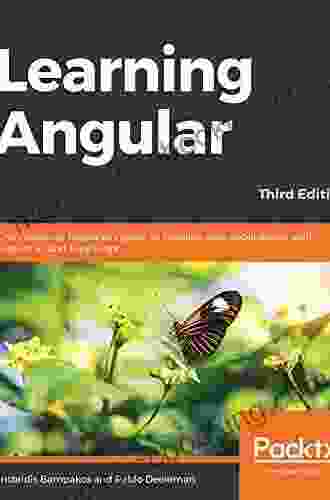No-Nonsense Beginner's Guide to Building Web Applications with Angular 10

In today's fast-paced digital world, web applications are an essential part of our daily lives. Whether it's for work, play, or anything in between, we rely on web apps to connect with others, access information, and complete tasks. If you're interested in learning how to build your own web applications, Angular 10 is an excellent framework to start with.
Angular is a powerful and versatile open-source framework that makes it easy to build scalable, maintainable, and performant web applications. It's used by some of the world's largest companies, including Google, Microsoft, and Our Book Library.
4.1 out of 5
| Language | : | English |
| File size | : | 4989 KB |
| Text-to-Speech | : | Enabled |
| Screen Reader | : | Supported |
| Enhanced typesetting | : | Enabled |
| Print length | : | 430 pages |
In this beginner's guide, we'll walk you through everything you need to know to get started with Angular 10, from setting up your development environment to creating your first web application. We'll cover all the basics, including components, directives, services, and routing.
By the end of this guide, you'll have a solid foundation in Angular 10 and be able to start building your own web applications.
Getting Started
To get started with Angular 10, you'll need to install the following software:
- Node.js (version 10 or higher)
- Angular CLI (version 10 or higher)
Once you have installed the required software, you can create a new Angular project by running the following command in your terminal:
ng new my-project
This command will create a new directory called my-project and install all of the necessary dependencies.
Once the project has been created, you can navigate to the project directory and start the development server by running the following command:
ng serve
The development server will run on port 4200 by default. You can access your application by visiting http://localhost:4200 in your browser.
Components
Components are the basic building blocks of Angular applications. They are reusable, self-contained units of code that define the structure and behavior of a specific part of your application.
Components are typically composed of three parts:
- Template: The template defines the HTML layout of the component.
- Class: The class defines the behavior of the component, such as its data and methods.
- Styles: The styles define the appearance of the component, such as its colors and fonts.
Here's an example of a simple Angular component:
@Component({ selector: 'my-component', template: '' }) export class MyComponent {}
This component defines a new HTML element called <my-component> that displays the text "Hello, world!".
Directives
Directives are used to modify the behavior of elements in your application. They can be used to add new functionality to elements, such as event handling or data binding.
There are two types of directives:
- Attribute directives: Attribute directives are applied to elements using attribute syntax.
- Structural directives: Structural directives are applied to elements using asterisks (*).
Here's an example of an attribute directive that adds a click event handler to an element:
@Directive({ selector: '[myClick]' }) export class MyClickDirective { @HostListener('click') onClick(){console.log('Clicked!'); }}
This directive can be applied to any element using the myClick attribute. When the element is clicked, the onClick() method will be called.
Services
Services are used to share data and functionality between different parts of your application. They can be used to store data, perform calculations, or communicate with external APIs.
To create a service, you can use the @Injectable() decorator.
@Injectable({ providedIn: 'root' }) export class MyService { getData(){return ['foo', 'bar', 'baz']; }}
This service defines a method called getData() that returns an array of data.
To use the service in your component, you can inject it into the constructor.
export class MyComponent { constructor(private myService: MyService) {}
ngOnInit(){this.data = myService.getData(); }}
Routing
Routing is used to navigate between different pages in your application.
To set up routing in your application, you can use the @Routes() decorator.
@Routes([ { path: '', component: HomeComponent },{path: 'about', component: AboutComponent }]) export class MyAppComponent {}
This decorator defines two routes: one for the home page and one for the about page.
To navigate between routes, you can use the Router service.
export class MyComponent { constructor(private router: Router) {}
goToAboutPage(){this.router.navigate(['/about']); }}
This is just a brief overview of the basics of Angular 10. For more in-depth information, I recommend checking out the official Angular documentation.
If you're looking to learn more about Angular 10, I also recommend checking out the following resources:
- Angular Tutorial
- Angular Documentation
- Angular Fundamentals Course
With a little effort, you'll be able to master Angular 10 and build amazing web applications.
4.1 out of 5
| Language | : | English |
| File size | : | 4989 KB |
| Text-to-Speech | : | Enabled |
| Screen Reader | : | Supported |
| Enhanced typesetting | : | Enabled |
| Print length | : | 430 pages |
Do you want to contribute by writing guest posts on this blog?
Please contact us and send us a resume of previous articles that you have written.
 Book
Book Novel
Novel Page
Page Chapter
Chapter Text
Text Story
Story Genre
Genre Reader
Reader Library
Library Paperback
Paperback E-book
E-book Magazine
Magazine Newspaper
Newspaper Paragraph
Paragraph Sentence
Sentence Bookmark
Bookmark Shelf
Shelf Glossary
Glossary Bibliography
Bibliography Foreword
Foreword Preface
Preface Synopsis
Synopsis Annotation
Annotation Footnote
Footnote Manuscript
Manuscript Scroll
Scroll Codex
Codex Tome
Tome Bestseller
Bestseller Classics
Classics Library card
Library card Narrative
Narrative Biography
Biography Autobiography
Autobiography Memoir
Memoir Reference
Reference Encyclopedia
Encyclopedia Anne Lyerly
Anne Lyerly Ann Zwinger
Ann Zwinger Barbara Gastel
Barbara Gastel Arielle Phoenix
Arielle Phoenix Anna Rashbrook
Anna Rashbrook Anna Ivey
Anna Ivey Asimina Nteliou
Asimina Nteliou Anne Baines
Anne Baines Anne Sophie Jouhanneau
Anne Sophie Jouhanneau Ann Valett
Ann Valett Anjan Chatterjee
Anjan Chatterjee Anna Reser
Anna Reser Anthony Sattin
Anthony Sattin Barbara Calamari
Barbara Calamari Arabella R Irvine
Arabella R Irvine Anton Canady
Anton Canady Ann Hazelwood
Ann Hazelwood Averie Rousseau
Averie Rousseau Ann Weil
Ann Weil Anthony Horowitz
Anthony Horowitz
Light bulbAdvertise smarter! Our strategic ad space ensures maximum exposure. Reserve your spot today!

 Roald DahlMuslim Doctor's Unwavering Journey to Provide Healing and Compassion in Rural...
Roald DahlMuslim Doctor's Unwavering Journey to Provide Healing and Compassion in Rural... Brandon CoxFollow ·17.1k
Brandon CoxFollow ·17.1k Emilio CoxFollow ·19.1k
Emilio CoxFollow ·19.1k Harold PowellFollow ·9.1k
Harold PowellFollow ·9.1k David BaldacciFollow ·6.4k
David BaldacciFollow ·6.4k Dale MitchellFollow ·9.7k
Dale MitchellFollow ·9.7k Zadie SmithFollow ·6.5k
Zadie SmithFollow ·6.5k Eric HayesFollow ·13.9k
Eric HayesFollow ·13.9k Roald DahlFollow ·8.9k
Roald DahlFollow ·8.9k

 Brayden Reed
Brayden ReedTeach Your Child They Have No Self Worth And They Will...
By Dr. Jane Doe ...

 Shawn Reed
Shawn ReedUnveiling Centuries of Tradition: History of Childbirth...
Journey into the heart of the...

 Brady Mitchell
Brady MitchellProven Guidelines For Healthy Multiple Pregnancy
Congratulations on your...

 Dylan Mitchell
Dylan MitchellHarness the Power of Sleep for Optimal Health and...
In the fast-paced,...

 Herman Melville
Herman MelvilleAlexander Hamilton: The Revolutionary Who Shaped...
Alexander Hamilton was a...
4.1 out of 5
| Language | : | English |
| File size | : | 4989 KB |
| Text-to-Speech | : | Enabled |
| Screen Reader | : | Supported |
| Enhanced typesetting | : | Enabled |
| Print length | : | 430 pages |










